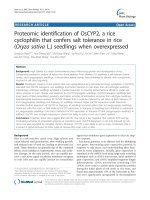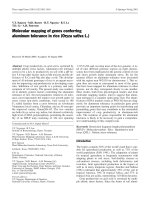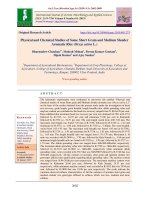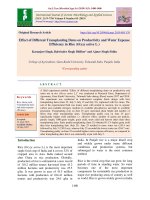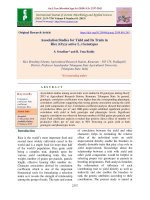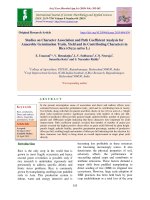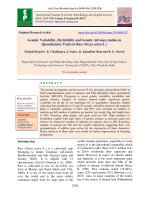Spikelet fertility restoration studies for identification of restorers and maintainers in rice (Oryza sativa L.)
Bạn đang xem bản rút gọn của tài liệu. Xem và tải ngay bản đầy đủ của tài liệu tại đây (166.46 KB, 4 trang )
Int.J.Curr.Microbiol.App.Sci (2018) 7(3): 942-945
International Journal of Current Microbiology and Applied Sciences
ISSN: 2319-7706 Volume 7 Number 03 (2018)
Journal homepage:
Original Research Article
/>
Spikelet Fertility Restoration Studies for Identification of Restorers and
Maintainers in Rice (Oryza sativa L.)
Ch. Ramesh*, Ch. Damodar Raju, Ch. Surender Raju and N. Rama Gopala Varma
Department of Genetics and Plant Breeding, College of Agriculture (PJTSAU),
Rajendranagar, Hyderabad - 500 030, Telangana, India
*Corresponding author
ABSTRACT
Keywords
Oryza sativa, CMS
lines, Restorer,
Spikelet fertility
and Test crosses
Article Info
Accepted:
10 February 2018
Available Online:
10 March 2018
A study was conducted on fertility restoration of 24 Rajendra nagar
genotypes to identify the restorers, partial restorers, partial maintainers and
maintainers. Twenty four genotypes were test crossed with IR 58025A
during rabi 2014-15 at Rice Research Centre, ARI, Rajendra nagar. Out of
24 genotypes 8 were identified as restorers, 10 were identified as partial
restorers and 6 genotypes were identified as partial maintainers. None of
them were identified as maintainers.
Introduction
Rice (Oryza sativa L.) is the most important
staple food crop for more than 60 percent of
the global population and most important crop
in Asia. Rice (Oryza sativa L.) is a staple food
for over 3 billion people (Cantral and Reeves,
2002).
In many countries, rice accounts for more than
70 percent of human caloric intake. In India
rice cultivation area is 44 million hectares and
production is 106 million tones where as
China produces 144 million tonnes from 30.6
million hectares. In China the rice production
is high due to high adoption of hybrid rice
where as India the hybrid rice adoption is
about 2.5 million hectares (RICESTAT 2014).
In hybrid rice seed production three-line
system and two-line systems are used. Mostly
three line or CGMS (Cytoplasmic Genic Male
sterility) system will be followed to eliminate
emasculation process.
The combination of a CMS line, maintainer
line and restorer line carrying the restorer gene
(Rf) to restore the fertility are indispensable
for the development of hybrids. The
establishment of test cross nursery to identify
restorers and maintainers is the first step in
three line heterosis breeding (Akhter et al.,
2008).
942
Int.J.Curr.Microbiol.App.Sci (2018) 7(3): 942-945
Materials and Methods
The CMS line IR 58025A and twenty four rice
genotypes of Rajendra nagar were comprised
the materials for present study. Those
materials were grown in source nursery at
Rice Research Centre, Agriculture Research
Institute, Rajendra nagar during rabi 2014-15.
The pollen parents were planted with a
spacing of 20 cm (row-to-row) x 15 cm (plantto-plant) in main field.
The CMS lines IR 58025A were tested to
assure 100 % pollen sterility before crossing.
The panicles of CMS lines were covered with
a butter paper at anthesis period to prevent
cross pollination. At 10-11 am the pollen was
dusted on panicles of IR 58025A CMS lines.
So utmost care was taken while test crossing
and crossed seeds from the combinations were
collected for their evaluation.
Estimation of spikelet fertility
Estimation was done on three panicles per
plant (two selected at random and one from
the main culm) from five randomly selected
plants for each testcross hybrid at maturity.
Spikelet fertility of hybrids was assessed by
taking the count of well filled and chaffy
spikelets in each panicle.
Spikelet fertility (%) = {No. of filled spikelets
panicle-1/total number of spikelets panicle-1} x
100
Classification of pollen parents
The pollen parents were classified into four
categories - Maintainers (M), Partial
Maintainers (PM), Partial Restorer (PR) and
Restorer (R) based on their spikelet fertility
percentages (Srijan et al., 2015) and presented
in the following study.
Results and Discussion
The test cross establishment is the initial step
in fertility restoration studies of three line
hybrid rice production. The results showed
that out of the attempted test crosses, 24 test
crosses were successfully evaluated (Table 1).
It was reported in some cases higher
frequency of maintainers (17%) than that of
restorers (11%) from 65 testcrosses (Akhter et
al., 2008).
The spikelet fertility of hybrids varied from
11.03 to 91.95. Similar observations have
been reported by other researchers (Ali et al.,
2014, Krishnalatha and Sharma 2012, Sharma
et al., 2012 and Srijan et al., 2015).
In this evaluation 8 genotypes were
completely restored, 10 genotypes were
partially restored and 6 were identified as
partial maintainers. None of them were
identified as maintainers. These 8 genotypes
(restorers) can contribute for the development
of good hybrids by utilizing them as parental
lines in hybridization programmes (Table 2).
In this investigation the finding were revealed
that fertility restoration reaction was varied
with genetic background. These identified
restorers were locally adopted genotypes. So,
we can use them in production of superior
hybrids for local climatic conditions.
943
Int.J.Curr.Microbiol.App.Sci (2018) 7(3): 942-945
Table.1 Fertility restoration study for identification of restorers and maintainers among 24 lines
test crossed with IR 58025A
S.
No.
1
2
3
4
5
6
7
8
9
10
11
12
13
14
15
16
17
18
19
20
21
22
23
24
Hybrids
IR 58025A × RNR 21615
IR 58025A × RNR 21604
IR 58025A × RNR 21304
IR 58025A × RNR 21218
IR 58025A × RNR 21301
IR 58025A × RNR 21288
IR 58025A × MTU 1010
IR 58025A × RNR 15048
IR 58025A × RNR 21677
IR 58025A × RNR 21606
IR 58025A × RNR 21230
IR 58025A × RNR 21297
IR 58025A × RNR 21290
IR 58025A × RNR 21232
IR 58025A × RNR 21219
IR 58025A × RNR 21236
IR 58025A × RNR 21222
IR 58025A × RNR 21287
IR 58025A × RNR 21243
IR 58025A × RNR 21295
IR 58025A × RNR 21229
IR 58025A × RNR 19397
IR 58025A x RNR 19311
IR 58025A × MTU 1001
Days to
50%
flowering
94
90
89
87
90
86
88
91
93
92
87
89
92
85
92
87
95
88
93
88
84
93
90
93
No. of filled
grains per
panicle
300
153
150
183
262
209
190
128
168
273
120
28
95
247
373
123
154
100
116
110
48
74
125
121
No. of
unfilled
grains
58
17
36
16
43
21
35
25
120
123
225
225
191
80
130
119
80
42
59
210
137
27
170
80
Total no.
of grains
368
170
186
199
305
230
225
153
288
396
345
253
286
327
503
242
234
142
175
320
185
101
295
201
Spikelet
fertility
%
81.52
90.00
80.60
91.95
83.90
90.08
84.44
83.60
58.33
68.90
34.00
11.03
33.21
74.50
74.15
50.80
65.81
70.42
66.28
34.37
25.94
73.20
42.37
60.19
Grain
yield per
plant
12.50
18.96
13.83
24.87
36.24
21.76
18.02
11.59
10.74
17.31
11.39
4.07
10.86
12.34
19..74
11.36
12.19
10.30
10.72
7.47
6.89
9.83
10.43
9.78
Fertility
reaction
R
R
R
R
R
R
R
R
PR
PR
PM
PM
PM
PR
PR
PR
PR
PR
PR
PM
PM
PR
PM
PR
Table.2 Classification of the lines studied based on fertility reaction of test cross hybrids
S. No.
Class
Spikelet
fertility
%
>75
No. of
genotypes
identified
8
1
Restorers
2
Partial
Restorers
50-75
10
3
Partial
Maintainers
Maintainers
0.1-50
6
0
0
4
List of genotypes
RNR 21615, RNR 21604, RNR 21304, RNR
21218, RNR 21301, RNR 21288, RNR 15048
and MTU 1010
RNR 21677, RNR 21606, RNR 21219, RNR
21236, RNR 21222, RNR 21287, RNR 21243,
RNR 19397, RNR 21232 and MTU 1001
RNR 21230, RNR 21297, RNR 21290, RNR
21295, RNR 21229 and RNR 19311
Nil
hybrids. Journal of Animal and Plant
Science 18(1): 39-41.
Ali, M., Hossain, M. A., Hasan, M.J and
Kabir, M. E. 2014. Identification of
maintainer and restorer lines in local
References
Akhter M, Zahid M A, Sabar M and Ahmad
M. 2008.Identification of restorers and
maintainers for the development of rice
944
Int.J.Curr.Microbiol.App.Sci (2018) 7(3): 942-945
aromatic
rice
(Oryza
sativa).
Bangladesh J. Agril. Res. 39(1): 1-12.
Cantral R.P and Reeves, T.G (2002). The
cereal of the world’s poor takes centre
stage. Science 296:53.
Krishnalatha S and Sharma D. 2012.
Identification of maintainers and
restorers for WA and Kalinga sources of
CMS lines in rice (Oryza sativa L.).
Electronic Journal of Plant Breeding
3(4): 949-951
Sharma S K, Singh S K, Nandan R and
Kumar M. 2012. Identification of
restorers and maintainers for CMS lines
of rice (Oryza sativa L.). Indian Journal
of Plant Genetic Resource 25(2): 186188.
Srijan, A., Sudheer Kumar, S., Damodar Raju,
Ch and Jagadeeshwar, R. 2015. Pollen
and Spikelet Fertility Studies for the
Identification of Good Restorers and
Maintainers in Rice (Oryza sativa L.).
Research Journal of Agricultural
Sciences. 6(4): 751-753.
How to cite this article:
Ramesh, Ch., Ch. Damodar Raju, Ch. Surender Raju and Rama Gopala Varma, N. 2018.
Spikelet Fertility Restoration Studies for Identification of Restorers and Maintainers in Rice
(Oryza sativa L.). Int.J.Curr.Microbiol.App.Sci. 7(03): 942-945.
doi: />
945
